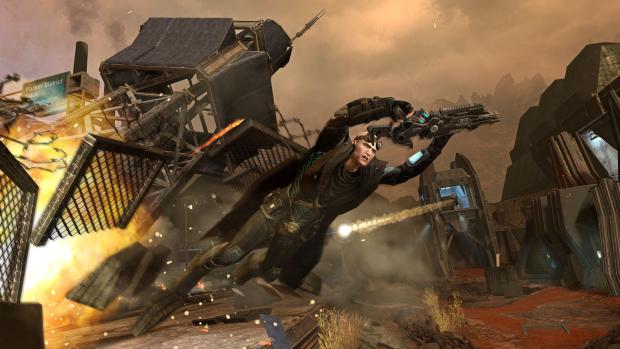Red Faction: Guerrilla was good, wasn’t it? I played the demo to death. I knew where all the enemies were, the weak spots that would bring each building down, and how to cause the most chaos. The objective was secondary – I was set loose in a fully destructible arena and just had fun.
And yet the full game managed to exceed my expectations. It was massive, but also full of things to do. Rarely was a base or hamlet not used in at least one mission or side-quest, and while they may not have been inspired themselves (most often go to X and kill everyone there) the scenery allowed for some inventive thinking, with missions playing out differently every time. Sniper at the top of a tower? Hammer away at the supports. Withering fire from the housing complex up ahead? Drive a lorry through the front door.
The opportunity to do things in any order you want to, the chance to just muck around blowing things up for fun if you didn’t want the constrictions of a mission holding you back – this freedom defined Guerrilla.

Naturally then, the sequel threw all of this out of the window. Armageddon returned to the series linear roots, taking place in underground caverns and replacing the human foes for aliens. The scene change may have been refreshing, but confining the player after the freedom of Guerrilla always felt like a step backwards.
This didn’t stop it being a decent third-person shooter, but it wasn’t a memorable one, the plot was something about pollution of the planet and an unknown alien presence under Mars’ crust… probably, as I say, it wasn’t memorable.
Poor sales led to THQ (R.I.P) cancelling the series, and it’s now in the possession of Nordic Games. There’s been no news on it’s future since then.

But imagine it came back. Imagine the physics it could pull off on the new consoles. Imagine it forgot Armageddon ever happened.
It wouldn’t need to be bigger, just more detailed. Mars, a decade or two later, the same area covered by Guerrilla, but now built up, the disparate hamlets formed into a city, terraforming diversifying the sections. Then Earth wants revenge: a war, an invasion, the player tasked with forming a revolutionary force from scratch.
It could work.
Destructible scenery powered by a PlayStation 4 or Xbox One would look incredible, no more remains sinking into the ground, but instead the world actually dynamically changing – a bridge between two buildings, felled at one end, providing an alternate route up for example, or a explosion sending debris out that could be used as cover.

Potentially it could be even bigger. Imagine a liquid system: water, lava and such. One mission could task you with destroying an enemy base situated at the bottom of a dam. Destroying the dam would sweep it away in a tidal wave, but it could also damage other portions of the surface, permanently change the game’s landscape where Guerrilla reset after a certain amount of time.
You see, although annihilating the scenery was fun, once it became normal a few hours into the game, once you stopped destroying things for the sake of it, it really brought fights to life. Call of Duty settles for objects in a room pinging about when hit by a stray bullet. In a new Red Faction though, a badly aimed rocket could take out a wall, and it wouldn’t be noteworthy – things other games do in a cut-scene are just what happen accidentally in the gameplay. It would be brilliant, and that’s precisely why it needs to return.





